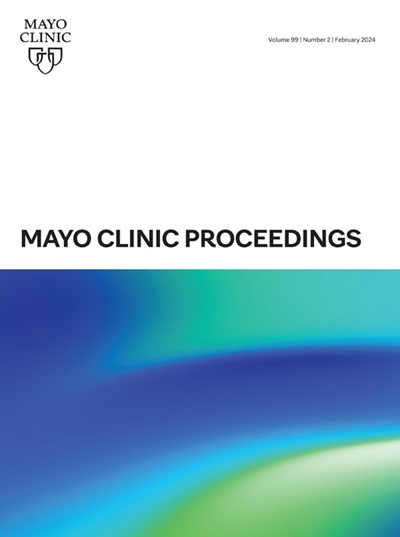早期吸烟对成年期生物加速衰老的影响。
IF 6.7
2区 医学
Q1 MEDICINE, GENERAL & INTERNAL
引用次数: 0
摘要
目的:探讨早期烟草暴露对成年期生物衰老加速的影响及其潜在机制。参与者和方法:本研究采用问卷调查的方式来确定参与者何时吸烟以及他们的母亲在怀孕期间是否吸烟。早期接触烟草包括子宫内接触烟草和开始吸烟的年龄。为了评估生物衰老,我们使用了以下8个结局指标:端粒长度、脆弱指数、体内平衡失调评分、klemera - double法生物年龄、年龄相关住院率、过早死亡和预期寿命。采用中介分析确定炎症因素的作用。结果:在14.6年的中位随访期间,分析了参与者开始吸烟年龄的8项结果测量(N=320,453)。与从不吸烟者相比,吸烟起始年龄为5 ~ 12岁(β=3.043;95% CI为2.683 ~ 3.403,β=-0.011;95% CI, -0.016 ~ -0.006), 13 ~ 17岁(β=1.343;95% CI为1.226 ~ 1.460,β=-0.007;95% CI, -0.009 ~ -0.005), 18岁及以上(β=0.949;95% CI, 0.823 ~ 1.075, β=-0.004;95% CI, -0.006至-0.003)与klemera - double法生物年龄增加、端粒长度缩短以及其他与衰老相关的结局指标显著相关。炎症标志物显著介导了上述研究关联的0.00%至43.58%。结论:子宫内接触烟草和较早开始吸烟与生物老化加速显著相关。这些关联部分是通过炎症标志物介导的。本文章由计算机程序翻译,如有差异,请以英文原文为准。

Effect of Earlier Age of Tobacco Exposure on Accelerated Biological Aging in Adulthood
Objective
To investigate how early-life tobacco exposures implicate accelerated biological aging in adulthood and the potential mechanism.
Participants and Methods
This study used questionnaires to determine when the participants smoked and whether their mothers smoked when pregnant. Early-life tobacco exposures included in utero tobacco exposure and age of smoking initiation. For evaluating biological aging, we used the following 8 outcome measures: telomere length, frailty index, homeostatic dysregulation score, Klemera-Doubal method biological age, age-related hospitalization rate, premature death, and life expectancy. Mediation analysis was used to identify the role of inflammation factors.
Results
During a median follow-up of 14.6 years, 8 outcome measures in participants were analyzed for age of smoking initiation (N=320,453). Compared with never smoking, smoking initiation at age 5 to 12 years (β=3.043; 95% CI, 2.683 to 3.403 and β=−0.011; 95% CI, −0.016 to −0.006), 13 to 17 years (β=1.343; 95% CI, 1.226 to 1.460 and β=−0.007; 95% CI, −0.009 to −0.005), and 18 years and above (β=0.949; 95% CI, 0.823 to 1.075 and β=−0.004; 95% CI, −0.006 to −0.003) were significantly associated with increased Klemera-Doubal method bioage and shorter telomere length, as well as with other aging-related outcome measures. Markers of inflammation significantly mediated up to 0.00% to 43.58% of the studied associations above.
Conclusion
In utero tobacco exposure and earlier age of smoking initiation were significantly associated with accelerated biological aging. These associations were in part mediated through inflammation markers.
求助全文
通过发布文献求助,成功后即可免费获取论文全文。
去求助
来源期刊

Mayo Clinic proceedings
医学-医学:内科
CiteScore
16.80
自引率
1.10%
发文量
383
审稿时长
37 days
期刊介绍:
Mayo Clinic Proceedings is a premier peer-reviewed clinical journal in general medicine. Sponsored by Mayo Clinic, it is one of the most widely read and highly cited scientific publications for physicians. Since 1926, Mayo Clinic Proceedings has continuously published articles that focus on clinical medicine and support the professional and educational needs of its readers. The journal welcomes submissions from authors worldwide and includes Nobel-prize-winning research in its content. With an Impact Factor of 8.9, Mayo Clinic Proceedings is ranked #20 out of 167 journals in the Medicine, General and Internal category, placing it in the top 12% of these journals. It invites manuscripts on clinical and laboratory medicine, health care policy and economics, medical education and ethics, and related topics.
 求助内容:
求助内容: 应助结果提醒方式:
应助结果提醒方式:


